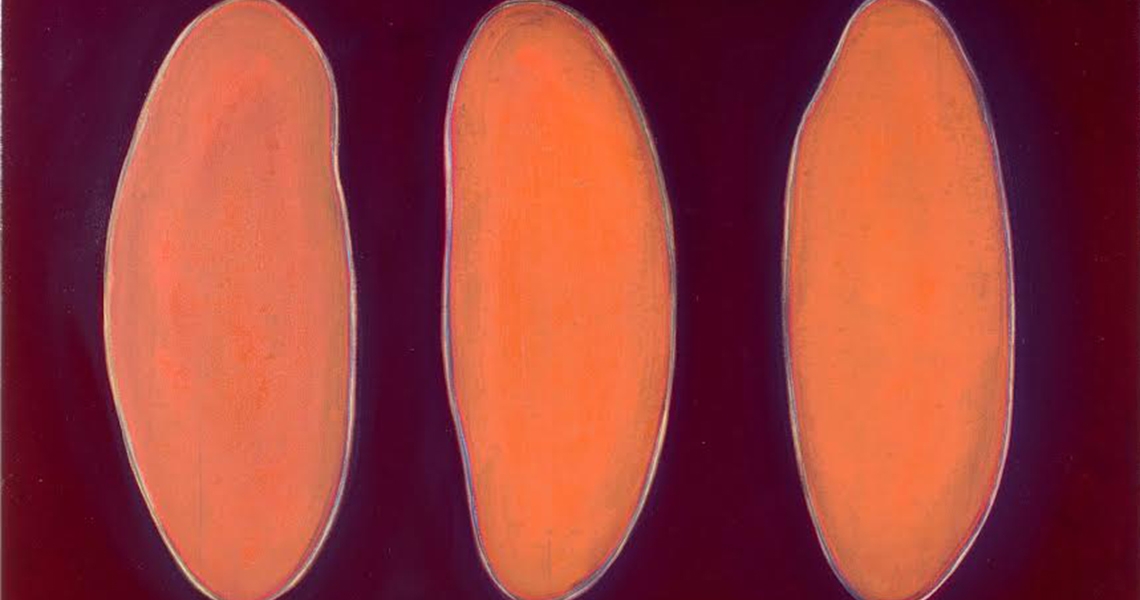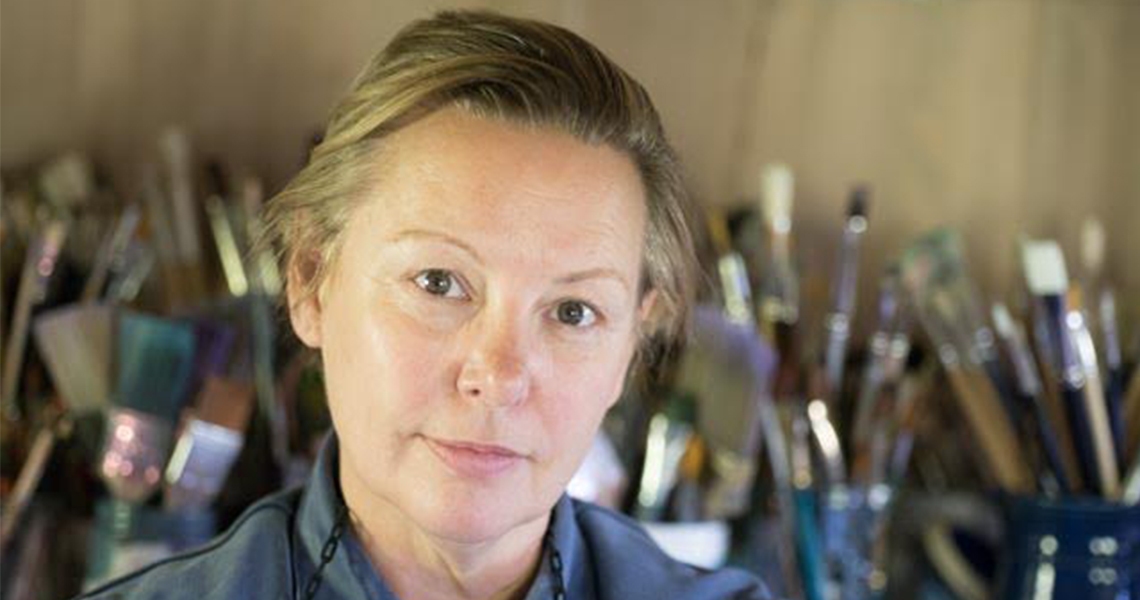
Heikedine Günther, a German painter who lives and works in Switzerland, is also the founder of Artem-Reich project, which aims at promoting unknown or aspiring Swiss artists. In our interview with Heikedine Günther and her fellow artist Blance Blatt who also belongs to Artem-Reich, we talked about their plans for 2016 Berliner liste as well as their background and interests when it comes to contemporary art. Heikedine devotes her artistic work solely to painting and her most famous series called Seeds examines the form of seed as the symbol of the soul, fertility, profundity, and the origin of the elements. When it comes to Blance Blatt, she is inspired by daily life occurences and she works with unusual non-artistic materials, such as table cloths, clothes and towels.
Perpetual Search for the Ideal Seed • Interview with Heikedine Günther
Dear Heikedine, for starters, tell us something about your art as well as your Artem-Reich project.
Heikedine Günther: At an early stage I was impressed by the work of Joseph Beuys in the 80s, and even if my career led me to other fields since 2002, I have always been following my work as a painter. I am dedicated to painting “seeds” since 2004, in the perpetual search for the ultimate ideal “seed”. For me, the seed represents the nucleus, the cell, the origin of life; the quintessence of things, primordial elements of life. I am working with oil colour mixed with painting butter to respect the materiality and to be able to experiment as much as possible to find out the ideal way of painting for me personally.The structure Artem-Reich was established in order to be able to show so far unknown Swiss artists abroad, it was a mere practical reason, I am looking for gallery presentation for both artists.
Your paintings feature simple geometric shapes along with complementary and contrasting colors. Is there any famous painter or art movement you consider your main influence?
HG: Even if the paintings don’t show this influence, but the encounter with Joseph Beuys when I was 16, deeply touched me. His consistent way of developing social sculpture guided by humanism were always a guideline in my career. Through my dedication to medieval manuscripts in the last 15 years, this part of art history has naturally influenced my paintings, even though it might sound pretentious, but the color, the contrast of colours and the soft and transparent hue of the motives in medieval manuscript illumination as well as the pigments used, have always strongly impressed me. The symbolic language of its colors fascinates me.
You’ll participate in our 2016 Berliner Liste this September. Will this be your debut art fair? If not, what are your previous experiences when it comes to exhibitions and art fairs?
HG: I have been visiting and exhibiting (not contemporary art, not my art though) on numerous art fairs worldwide – Tefaf, Frieze, ARCO, Art Basel, Art Basel Miami Beach, Armory New York, etc., and these experiences have shaped my way of looking at art from all eras and standpoints. But this is the first fair where I am going to exhibit my personal work and I am actually quite excited about this, because it is the first time that I have to defend my art. And this is far more difficult than talking about medieval manuscripts and early printed books, because they are part of myself, of my personal evolution, they show something of myself to the public.

Heikedine Günther’s Portrait (Left) / Untitled from Seeds Series (Right)
You’re originally from Switzerland, but you decided to showcase your art here in Germany. Is there any specific difference when it comes to contemporary art scene in Germany and Switzerland?
HG: Actually I am originally German and I moved to Switzerland some years back. I have decided to exhibit for the first time at an art fair in Germany, and specifically in Berlin, one of the main spots of contemporary art in Europe, because I want to have serious feedback to my art, I want to engage with a serious art public which is also interested in younger in the sense of unknown positions. Even though Switzerland has the world’s most renown art fair and many museums and art spaces for contemporary art, I always have the impression that the contemporary art scene in Germany is more international, more open and allows more experimentation.
What are your plans and expectations when it comes to 2016 Berliner Liste? Are you intereste in finding individual artists or galleries to collaborate with?
HG: Since it is my first participation as an artist in a contemporary art fair, I am interested in getting to know the scene, the market and the stakeholders. I want to engage with galleries and artists, exchange ideas. I am looking forward to talk with collectors and curators and get their feedback, I want to be challenged by exchanging ideas with the public. I am definitely interested in finding German and international galleries who would be interested in showing my work. I want to broaden my international network!
Besides painting, are you interested in any other visual arts? Do you often visit local or international galleries and museums?
Yes, absolutely. My life has been moving around arts ever since I can remember, I need art as I need the air to breathe, I need the challenge and the knowledge which it is providing. I have been traveling the globe with my recent occupation around medieval manuscripts and I adore to discover new and old museums as well as galleries in New York, Sydney, Paris, London, Madrid, Hamburg, Berlin, Zurich and so on. One of my favorite museums is the Metropolitan, I love the Louvre, where I can always dive into the fundaments of contemporary art, the art works which have been influencing contemporary artists worldwide. Museums and galleries are the best spots where you can find inspiration and build knowledge, they are the pillars of cultural education. And this combined with traveling is the most important source of inspiration and education for an artist.
Collecting Unique Fabrics • Interview with Blance Blatt

Blance Blatt’s Portrait
Blance, your artworks represent an interesting combination of anthropomorphic figures and geometric shapes with strong outlines. You also don’t use regular white canvases for your art. We would like to know more about your painting process and your sources of inspiration.
Blance Blatt: I take my inspirations from daily life. There are series focusing on specific subjects like “Mondman” which are painted onto antique gunnysacks (still showing their original function and history), but also onto table cloths, clothes, towels, just as it is fitting into the moment. The colors are natural pigments mixed with wallpaper paste applied to the fabric, a technique which was used by Paul Klee. Overtime I elaborated countless paintings on fabric which I stored in boxes and suitcases. Each painting gets framed into a particularly chosen antique or at least used frame, fitting the work directly into the frame without mounting it on a stretcher.
You’ll participate in our 2016 Berliner Liste this fall. Have you already taken part in some art fairs before and if so, what were your experiences?
BB: I have been participating in many exhibitions in galleries and exhibition spaces, but it is my first contemporary art fair.
What are your plans and expectations when it comes to 2016 Berliner Liste? What are you most looking forward to?
BB: I have no expectations, to be honest. But I am looking forward to see people exchanging with my works, and will be happy to get feedback from the public. Of course, it would be nice to see one work or the other move into a private collection and change the context.

Blance Blatt’s Artworks
You’re coming from Switzerland, a country that has many art connoisseurs and collectors. But how about Swiss artists themselves? Are there many young aspiring artists in your hom country? Do you have any contact with them?
BB: Sincerely, I don’t know many living Swiss artists, but there are many as far as I can see from visiting exhibitions. But I am kind of secluded from this scene, living and working in the countryside.
Have you ever been to Berlin before and when did you hear about the Berliner Liste for the first time?
BB: I know Berlin quite well. After the reunification, from 1992-93, I lived in Berlin Wartenau. It was an unforgettable moment. The smell of lignites, floor wax and polish of public buildings is still deeply anchored in my memories. I heard about the Berliner Liste from two different persons the same day: The gallerist Mehdi Chouakri and the artist Zoyt, both based in Berlin. I thought this was a sign and said: Let’s go to Berlin!
Besides painting, are you engaged in any other visual arts? Who is your favorite contemporary artist?
BB: I am collecting antique Coptic-Egyptian fabrics of the 2nd til 4th centuries. I write poetry, dedicate a lot of time into designing gardens and collect children’s books as of 1945. I admire the work of Anselm Kiefer, Irma Blank, Lee Ufan, Qiu Shihua, William Scott and Sean Scully.


